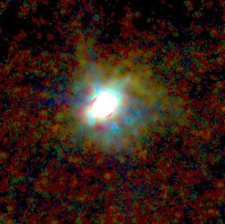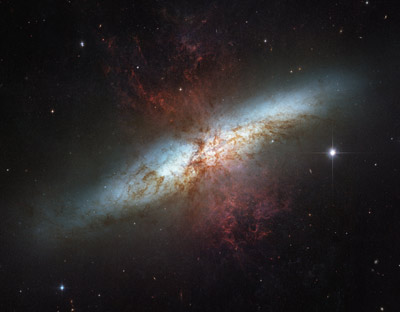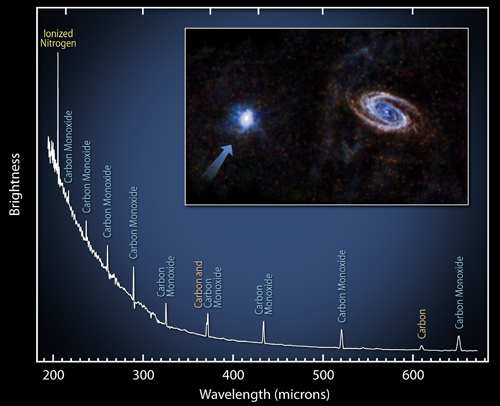| Basic Information | |
| What is this? | A spectrum of the starburst galaxy Messier 82, with an inset showing the Herschel image of Messier 82 along with its nearby neighbour Messier 81 |
| Where is it in the sky? | In the constellation of Ursa Major, the Great Bear |
| How big is it? | The galaxy is around 40,000 light years across |
| How far away is it? | About 12 million light years away |
| What do the colours represent? | The spectrum shows the brightess of the galaxy over a range of wavelengths, with spikes due to specific atoms and molecules. In the inset, blue material is hotter and red colder. |
See this object in:
The galaxy Messier 82 is a fairly small galaxy, with a mass less than a tenth of the Milky Way’s, but can be studied in great detailed due to being so close. At around 12 million light years away, Messier 82 is one of the best studied examples of a “starburst galaxy”. The image above shows the spectrum of the far-infrared light from the galaxy, as measured by the SPIRE instrument onboard Herschel. The spikes are “emission lines” from atoms and molecules which emit at very specific wavelengths – in this case carbon, carbon monoxide and ionised nitrogen. The chemical makeup of the gas is determined by comparing the precise wavelengths of the emission lines with the results of measurements in labs on Earth. The relative brightnesses of the emission lines at different wavelengths tell astronomers information about the environment in which the molecules are sitting, such as the temperature of the gas.

FAR Infrared (Herschel) 
Optical (Hubble)
Despite its small size, this little galaxy is forming stars at around 10 times the rate of our Galaxy. The reason for this is the relatively recent (in astronomical terms) encounter with its close neighbour Messier 81 (shown on the right in the inset above). The latest encounter is thought to have occurred around a hundred million years ago, during which Messier 82, as the smaller of the two galaxies, was significantly disrupted. It has previously been calles the “cigar galaxy” due to its perculiar shape. The high rate of star formation makes Messier 82 the brightest galaxy in the sky at infrared wavelengths, as shown in the image on the right. The lower image of the galaxy in optical light, from the Hubble Space Telescope, shows a distorted disc (seen almost completely edge-on) with plumes of material being blown from the central regions. This material in the Hubble image is primarily hot hydrogen gas, which is heated by the intense starlight from bright stars in the galaxy’s core.
Previous studies have shown that there is a lot of cold gas in the galaxy, at temperatures of around 30K (-240oC), but Herschel has made measurements at wavelengths normally block by the Earth’s atmosphere. These Herschel observations have confirmed that there is also much warmer gas, at temperatures of around 500K (+230oC). This agrees with measurements by previous spacecraft, Spitzer and ISO, made at shorter wavelengths, which are based on measurements of hydrogen gas. The different wavelength ranges are sensitive to different molecules. The source of the heating is still yet to be confirmed, but the most likely source is the turbulence created by the rapid star formation – with strong stellar winds stirring the gas up and warming it. When stars form in bursts, the biggest stars burn brightest but do not live for long. The supernova explosions which occur when these massive stars die will also have a small warming effect due to the very energetic particles, or “cosmic rays”, which are produced. Over time, the gas gradually cools, losing energy as the various types of molecules, such as carbon monoxide and water, emit the light which is then detected by Herschel and other telescopes.

